How LinkedIn support can uplevel to Microsoft’s 5-star quality
April 7, 2023
Consistently great customer service is hard enough. Doing it across multinational giants like Microsoft is a challenge fit only for a bona fide Chief Customer Officer. Nonetheless, there are modest changes that could lead to meaningful customer outcomes and help associate high quality and satisfaction with all Microsoft brands.
As a long-time partner, customer, and investor of Unbabel, we’re deeply engaged with Microsoft’s mission to provide world class customer support. This post will talk about a few things that the flagship Microsoft brand LinkedIn can do, following in the footsteps of your counterparts within the Xbox business unit.
We help Xbox leverage their best agents to speak with any customer, regardless of language. That simplifies hiring, training and leads to greater product specialism for Xbox, and with more agents available at any time, better resolution rates for customer. Pretty good deal.
Why do customers care about native language support?
First of all, language isn’t a trivial “nice-to-have”, it’s the key to positive customer engagement. An Unbabel survey of global consumers found that more than two-thirds (69%) believe it’s extremely or very important that brands offer an end-to-end customer experience in their native language, and moreover, 57% believe that not offering native support is a bias.
Meeting customers where they are can sound like a buzzword, but if it’s actually done it’s a key factor in driving loyalty over other brands.
Read the complete consumer survey
State of LinkedIn Premium support
Let’s have a look at how LinkedIn Premium – the paid solution – sets up support. At first glance, there are real positives: they have two channels, support seven languages, and have good response times. But you quickly can see opportunities for game-changing improvement.
First of all, there’s a big consistency issue because LinkedIn’s free version offers many more languages than Premium, here is the list for LinkedIn’s free support:
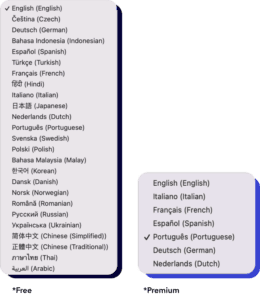


Compare to what they offer for email support for LinkedIn Premium, that lists shrinks dramatically:
That problem gets compounded when you go to live chat, which LinkedIn Premium only offers in English. We attempted to contact LinkedIn in Portuguese to find out if they offered support to their 64 million Portuguese speaking customers, but we were disappointed.
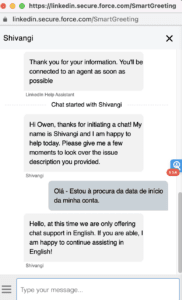


Support organizations that have different experiences (i.e. language) for different channels see lower CSAT because customers get frustrated. It all comes back to expectations.
Let’s now look deeper at the channel where LinkedIn Premium users do get multilingual support: email. It’s great that LinkedIn providers support a sizable number of customers speaking Italian, French, German, Portuguese, Spanish and Dutch. However it raises a new problem, consistency across markets because of the mixed translation quality.
Using Unbabel’s Quality Estimation technology (try it here), that measures the linguistic quality of any translation, we were able to determine that LinkedIn performs really well with German, scoring 98 MQM points:



MQM or Multidimensional Quality Metric, is a leading linguistic quality evaluation framework.
As far as MQM goes, anything above 95 we consider as Best – as the name suggests it is superlative, with minimal, if any, errors, and high fidelity to brand tone and voice.
However, when we look at Italian, that number free falls down to 64 MQM:
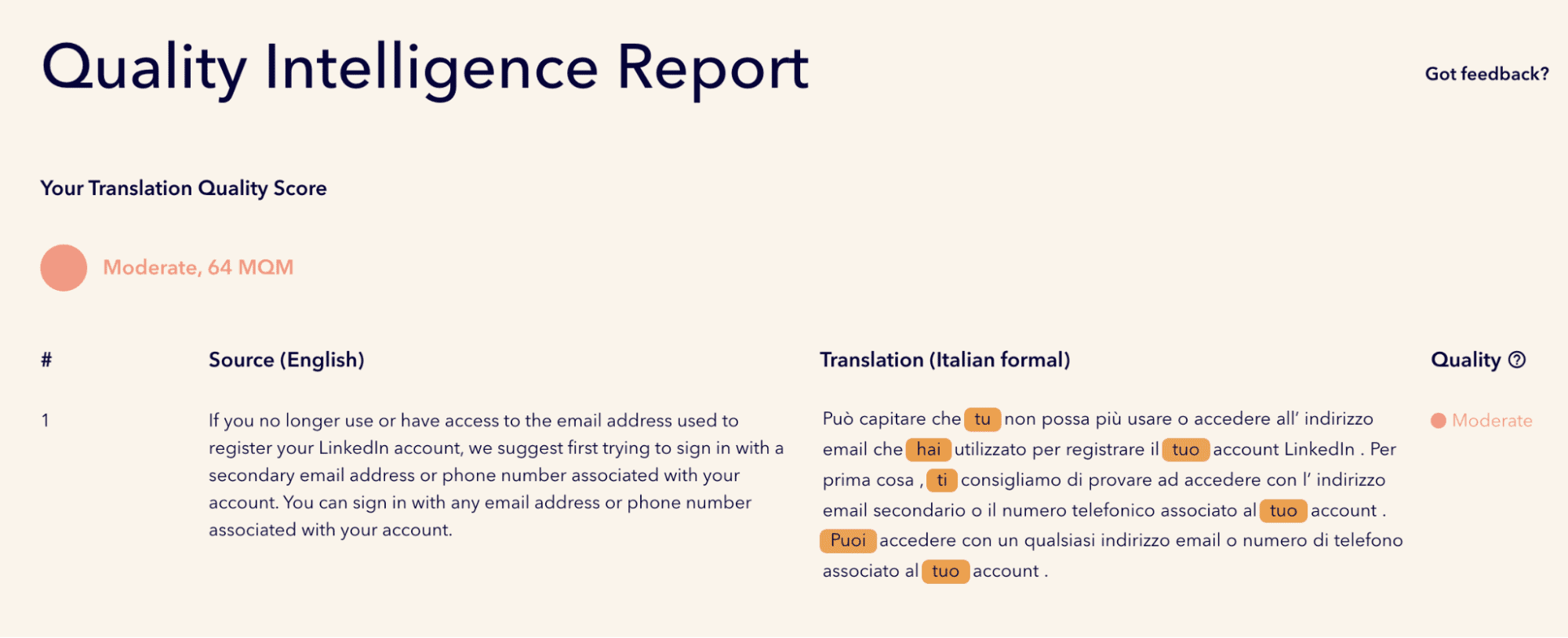


Unbabel classifies 64 MQM this as ‘Moderate’, but only just, since ‘Moderate’ starts at 60 MQM. We describe this quality level as: The translation has quite a few errors. The message and communication may only be partially understandable.
This isn’t is not how a professional network wants to engage with paying users. LinkedIn’s challenge is how to provide the same great, local experience that German users receive to the rest of their users.
Meanwhile, when using Unbabel’s translation, we’re able to raise that very same English-Italian translation to 96 MQM (when we included a human review):



You can try out Unbabel free today to test it out yourself.
What’s the bigger opportunity for LinkedIn?
It’s in LinkedIn’s interest to convert as many users as possible to paid and to keep them happy. The opportunity is big, with Europe’s 115 million users, the 106 million in Latin America and 97 million in east and southeast Asia.
What’s the solution?
Fortunately, there is a way to create a consistent, quality language experience across all of LinkedIn Premium’s channels.
First, roll out languages to chat, making the experience consistent with email. This can be done by either hiring full-time staff, using offshore solutions, or turning to a solution like Unbabel, who can make their agents multilingual. LinkedIn can consider a knowledge base solution or a dynamic chatbot like Ada, but they have to be ready for escalation with agents on standby.
Second, LinkedIn can perform quality checks on all their languages to make sure that their Premium customers are in fact getting the best support.
Third, LinkedIn should look to expand their language support offering to other big markets – such as the 57 million users in China, the 13 million + Arabic speakers, as well as potentially high reward markets in the Nordics.



The journey continues with their support page – also in German – which sets the expectation about the type of support they will receive:



Next, when the user starts a chat, they have the same smooth experience. But the agent they’re communicating with is actually an English speaker supported by Unbabel:
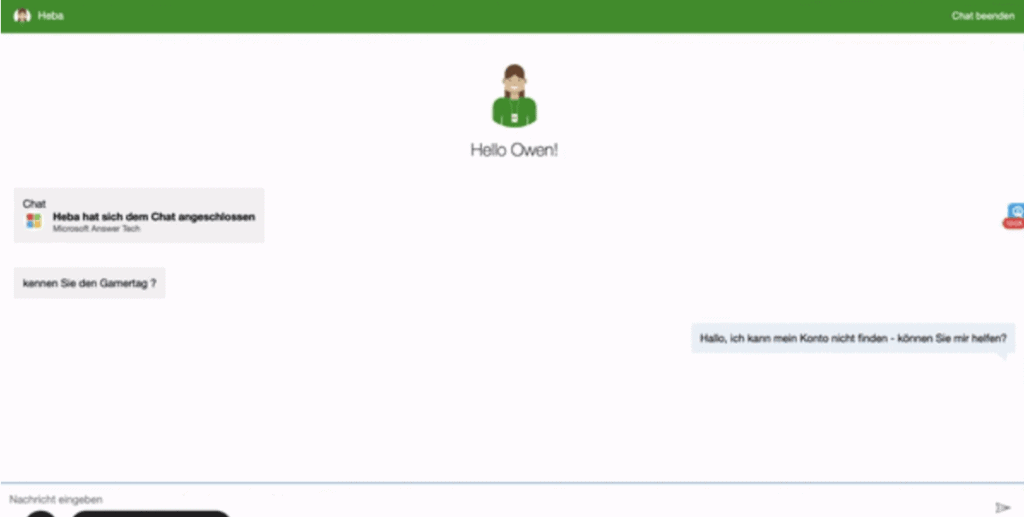


This lets Microsoft avoid creating expensive service silos based on markets, and instead can turn agents into product specialists while maintaining great support.
The results speak for themselves, reflected in the high scores in German for Xbox support:
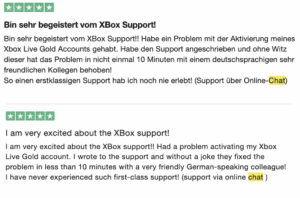


This customer had a spectacular experience on chat, and even believed that the agent was a German speaker, when actually it was an English speaker.
Working with Unbabel, Microsoft made some important changes to their support infrastructure, most notably that they don’t need to hire for language, and could rely on English speaking agents, leveraging their deep knowledge of the product, to provide great service to any customer. This approach actually saved Microsoft 51% of costs in providing multilingual support because they were able to remove much of the friction and redundancy that language siloes create.
This approach; the right agents empowered to speak with any customer, unblocked challenges around utilization and availability, meaning customers experienced faster replies and resolution (in one instance resolution increased by 20%), leading to a jump in CSAT by 10 points. LinkedIn might consider following suit.
Conclusion
We know that consistent, simple customer experiences are at the heart of great support, which in turn leads to customer loyalty. This is also hard to carry out, but LinkedIn is no different from the other huge multinationals we work with like Logitech, Booking.com, UPS, Adidas, and certainly not so different from Xbox.
If LinkedIn can create a coherent journey across email, chat and their knowledge base, they’ll be in place to more quickly and effectively provide support to their most valuable customers. Consistency is difficult to achieve, but it’s so much harder with multiple siloed teams all offering service in a vacuum – that’s what makes scaling so hard, and must be one of the big blockers for chat.
There is a way to make agents multilingual, break down barriers and unlock utilization so they speak with any customer no matter the language, to provide memorable, effective, delightful support.
Ready to get started?
Sign up for a demo below!



